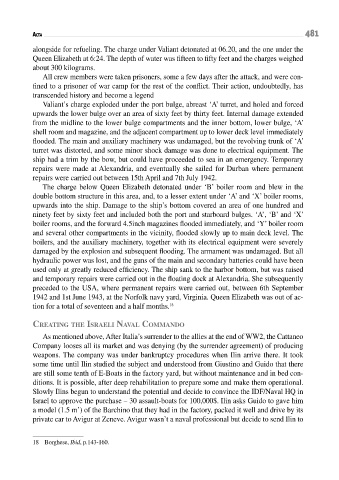Page 481 - Conflitti Militari e Popolazioni Civili - Tomo I
P. 481
481
aCta
alongside for refueling. The charge under Valiant detonated at 06.20, and the one under the
Queen Elizabeth at 6:24. The depth of water was fifteen to fifty feet and the charges weighed
about 300 kilograms.
All crew members were taken prisoners, some a few days after the attack, and were con-
fined to a prisoner of war camp for the rest of the conflict. Their action, undoubtedly, has
transcended history and become a legend
Valiant’s charge exploded under the port bulge, abreast ‘A’ turret, and holed and forced
upwards the lower bulge over an area of sixty feet by thirty feet. Internal damage extended
from the midline to the lower bulge compartments and the inner bottom, lower bulge, ‘A’
shell room and magazine, and the adjacent compartment up to lower deck level immediately
flooded. The main and auxiliary machinery was undamaged, but the revolving trunk of ‘A’
turret was distorted, and some minor shock damage was done to electrical equipment. the
ship had a trim by the bow, but could have proceeded to sea in an emergency. Temporary
repairs were made at Alexandria, and eventually she sailed for Durban where permanent
repairs were carried out between 15th April and 7th July 1942.
The charge below Queen Elizabeth detonated under ‘B’ boiler room and blew in the
double bottom structure in this area, and, to a lesser extent under ‘A’ and ‘X’ boiler rooms,
upwards into the ship. Damage to the ship’s bottom covered an area of one hundred and
ninety feet by sixty feet and included both the port and starboard bulges. ‘A’, ‘B’ and ‘X’
boiler rooms, and the forward 4.5inch magazines flooded immediately, and ‘Y’ boiler room
and several other compartments in the vicinity, flooded slowly up to main deck level. The
boilers, and the auxiliary machinery, together with its electrical equipment were severely
damaged by the explosion and subsequent flooding. The armament was undamaged. But all
hydraulic power was lost, and the guns of the main and secondary batteries could have been
used only at greatly reduced efficiency. The ship sank to the harbor bottom, but was raised
and temporary repairs were carried out in the floating dock at Alexandria. She subsequently
preceded to the USA, where permanent repairs were carried out, between 6th September
1942 and 1st June 1943, at the Norfolk navy yard, Virginia. Queen Elizabeth was out of ac-
tion for a total of seventeen and a half months. 18
creating the israeli naVal cOMMandO
As mentioned above, After Italia’s surrender to the allies at the end of WW2, the Cattaneo
Company looses all its market and was denying (by the surrender agreement) of producing
weapons. The company was under bankruptcy procedures when Ilin arrive there. It took
some time until Ilin studied the subject and understood from Giustino and Guido that there
are still some tenth of E-Boats in the factory yard, but without maintenance and in bed con-
ditions. It is possible, after deep rehabilitation to prepare some and make them operational.
Slowly Ilins begun to understand the potential and decide to convince the IDF/Naval HQ in
Israel to approve the purchase – 30 assault-boats for 100,000$. Ilin asks Guido to gave him
a model (1.5 m’) of the Barchino that they had in the factory, packed it well and drive by its
private car to Avigur at Zeneve. Avigur wasn’t a naval professional but decide to send Ilin to
18 Borghese, Ibid, p.143-160.

